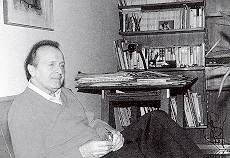

Considered by many the best of the Italian Disney authors, Romano Scarpa is both an artist and a writer. Born in Venice in 1927, he joined Disney (actually Arnoldo Mondadori, the Italian publisher that, at the time, had the rights to Disney comics) in 1953 after having worked in cartoon animation for his own small studio. A great fan of Gottfredson's Mickey Mouse adventures, he soon followed in his master's steps: when in 1955 the U.S. daily strips became self-contained gags instead of long adventures, he set himself to recreate the atmosphere and suspence of the old classics. He succeeded so well that many thought his stories were Gottfredson's. Many of his greatest stories have been written by him, but much of his work is also based on other writers' scripts. He prefers Mickey, but this doesn't stop him from drawing wonderful duck stories. He has enriched the Disney universe with many new characters, several of whom have been adopted by other writers both in Italy and abroad; among his creations are Atomino Bip Bip, Trudy, Brigitta, Filo Sganga, Plottigatt, Paperetta Yč Yč, Bruto and others. He has been an inspiration and a model for many other Italian artists, first and foremost Giorgio Cavazzano who started as his inker.
The definitive reference on Scarpa is this book ("the Blue book"):
Luca BOSCHI, Leonardo GORI, Andrea SANI,
Romano Scarpa, un cartoonist italiano tra animazione e fumetti,
Alessandro Distribuzioni, 1988.
Among other things it contains a 40-page interview with Scarpa and a detailed index of all his stories compiled by Alberto Becattini. Scarpa's photo above and the panel with Scarpa's own characters have been scanned in from this book.
The book is rather hard to come by, so here is the address of the publisher:
Alessandro Distribuzioni s.r.l.
Via del Borgo 140 ABC
40126 Bologna, Italy
Phone (+39 51) 240168.
Some more information on Scarpa can be found in a later book ("the Yellow book") by the same authors, a comprehensive treatise on all the Italian Disney authors.
Luca BOSCHI, Leonardo GORI, Andrea SANI,
I Disney Italiani,
Granata Press, 1990.
This is my personal breakdown of Scarpa's periods; of course, anything involving aesthetic judgement is going to be highly personal, so your mileage may vary and you may disagree with some or all of my classification. Note that the boundaries between the periods are based primarily on art, not scripts. Of course the transitions are never as abrupt as the years seem to indicate -- there is substantial overlap. The names identifying the periods are of my invention. For the references I am indebted to Alberto Becattini's excellent chronology of Scarpa's work, to be found in the Blue book quoted above. I have read all the stories I quote, of course, but sometimes only in a reprint. Most of the pictures have been scanned in from reprints and for this reason the colour is occasionally missing.
His mice start out very Gottfredson-like; indeed, many readers thought his stories were actually from Gottfredson himself. The stroke is spiky but attractive. His ducks are peculiar, sort of squeezed. In this period he writes some of his best plots, although he hasn't yet attained his graphical apogee.
This is a transition phase. The characters are drawn very dynamically, so much so that they sometimes look slightly out of proportion. They seem to want to grow out of the simpler and more naive shapes they had in the preceding period and the nervous stroke is part of the attractiveness of this otherwise minor phase.
Graphically, this is Scarpa at his best. An uncluttered, neat, elegant stroke with beautiful proportions. To me, very few Disney artists have ever come close to this perfection. And it sure didn't hurt that the great Giorgio Cavazzano, then at the start of his career and virtually unknown, was inking his pencils.
A long period of consistently good art. The style and proportions are those perfected in the Archetipal period, although there is that little bit that is different. Hard to precisely define the boundaries of this period.
Same proportions again but the stroke becomes heavier; the characters are simpler, more rubber-like. In this phase many new young artists start to take him as a model and there almost is an inflation of would-be Scarpas (not as many as the would-be Cavazzanos though!) Perhaps due to this, there is in some stories a certain feeling of tiredness in the art, which however disappears in others, most notably in those beautiful long stories where the Master writes his own plot. In this period he also introduces the "strip stories", a tribute to the Gottfredson days.
It must be noted that the differences between Archetipal, Maturity and Modern are in fact rather subtle when compared to the differences with and between the previous periods. If one wanted to simplify, one could identify only two periods, the "old" one with the best plots and the "new" one with the best art, with the boundary somewhere around 1966-1967.
Frank (Filologo Disneyano)